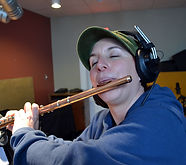top of page

Two of our Finest Songwriters


Rozalind MacPhail, flutist
Music Distribution
With the shift to digital distribution the music industry has changed fundamentally. Before this change, recordings were seen as "product" and distribution and promotion focused on albums, produced first as long playing vinyl records (LPs), then for a time as cassettes, and later as compact discs (CDs) carrying a digital wav file of the music. Now with digital transmission, downloading and streaming, music content is either taken for free, licensed or sold through digital outlets like iTunes via distributors like CD Baby.
This means that revenues from sales have drastically decreased. Except when sold as merchandise ("merch") as a sideline to live performance, more and more music is being downloaded, sold online or streamed, with less and less revenue reaching record companies, and even less ending up with artists.
In the public debate over musical rights, music consumers have largely lost site of the work that goes into creating, rehearsing and recording music, and more and more, consumers feel they have a right to use recorded music without compensating creators. Regardless of changes in distribution and gaps in copyright law, the artist must adapt to survive.
Many musicians are not aware of the rights they already hold under existing royalty schemes. New markets have opened up in the areas of ringtones, video game soundtracks, movie and television use and ambient or background music. In these markets, it is possible to reclaim some of the revenue lost through the depletion of direct sale of recordings. To access these new streams requires perseverance and paperwork. Assistance with identifying and applying for royalties and revenues is critical.
Expanding music distribution and realizing the full potential for use of your original content requires networking, promotion and marketing. As a music publisher, we can help with this.
You should be tapping all of the following revenue streams: direct recording sales, music downloading, licensing for television and radio (synchronization rights), use in performance and radio (performing rights), royalties paid to musicians who record music and music producers (neighbouring rights) and finally the residual royalties paid to North American recording musicians through the Sound Recording Labor Agreement. If you need help identifying, applying and accessing these streams, we can help.
In general, music distribution requires creating partnerships with the groups and organizations that take music out to users, including all the new users identified above. Success in this area has become critical to an artist's survival. We are able to help in this area.
We are always happy to share what we know. Please contact us if you need help or advice about the distribution of your music or wish to find support for your music distribution and rights licensing.
bottom of page